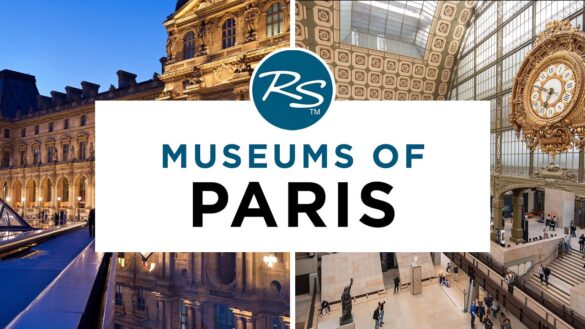Paris, renowned for its rich cultural heritage and artistic legacy, is home to some of the world’s most esteemed museums. The city’s museums offer a fascinating journey through art, history, and sculpture, each with its own unique character and collection. Among these cultural treasures, the Cluny Museum, Louvre Museum, Orsay Museum, Rodin Museum, and Orangerie Museum stand out as must-visit destinations.
This comprehensive guide delves into each of these five exceptional museums, exploring their historical significance, notable collections, and what makes them standout highlights in the Parisian art scene.
Cluny Museum: A Journey Through Medieval History
Overview and Historical Significance
The Musée de Cluny, officially known as the Musée National du Moyen Âge, is a remarkable repository of medieval artifacts and art, nestled in the heart of Paris. Housed in a former Roman bathhouse, the museum itself is a historical monument, dating back to the 3rd century AD. The Cluny Museum offers a captivating glimpse into the Middle Ages, showcasing a diverse range of exhibits that span over a millennium of medieval life, art, and culture.
Key Collections and Exhibits
One of the museum’s most celebrated exhibits is the Lady and the Unicorn tapestry series. These magnificent tapestries, dating from the late 15th century, are considered masterpieces of medieval art. The series features rich symbolism and intricate details, offering a visual narrative that intertwines themes of love, desire, and the senses. Each tapestry is a testament to the artistry and craftsmanship of the period, and they remain a highlight of the museum’s collection.
In addition to the tapestries, the Cluny Museum boasts an extensive collection of medieval sculptures, illuminated manuscripts, and religious artifacts. The museum’s collection includes exquisite examples of medieval stained glass, intricate jewelry, and ornate ceremonial objects that provide insight into the religious and cultural practices of the time.
The museum’s setting within the remains of the Gallo-Roman baths adds to its historical allure. Visitors can explore the ancient bathhouse’s subterranean rooms, offering a rare opportunity to experience a piece of Roman history in the heart of Paris.
A Culture Guide on Best Museums of Paris by Rick Steves. Museums in the Video Include :
- 00:00 Cluny Museum
- 03:24 Louvre Museum
- 09:10 Orsay Museum
- 12:51 The Rodin Museum
- 15:18 The Orangerie Museum
Louvre Museum: The Pinnacle of Art and History
Overview and Historical Significance
The Louvre Museum is arguably the most famous museum in the world, and its vast collection spans thousands of years and countless civilizations. Originally a royal palace, the Louvre has evolved over the centuries into a global cultural landmark, showcasing an unparalleled array of art and historical artifacts. The museum’s grand architecture, including the iconic glass pyramid designed by I. M. Pei, stands as a symbol of the Louvre’s transformation from a royal residence to a modern museum.
Key Collections and Exhibits
The Louvre’s collection is vast and diverse, encompassing Egyptian antiquities, Greek and Roman sculptures, and masterpieces from the Renaissance and beyond. Among its most renowned exhibits is Leonardo da Vinci’s Mona Lisa, an enigmatic portrait that draws millions of visitors each year. The Mona Lisa’s mystique and artistic brilliance make it one of the museum’s most iconic works.
Another highlight is Eugène Delacroix’s Liberty Leading the People, a stirring depiction of the July Revolution of 1830. This masterpiece captures the spirit of revolution and freedom, showcasing Delacroix’s dramatic use of color and form.
The Louvre also houses an impressive collection of ancient artifacts, including the Venus de Milo and the Winged Victory of Samothrace, both of which are celebrated for their historical and artistic significance. The museum’s extensive galleries provide a comprehensive overview of art history, from ancient civilizations to the modern era.
Architecture and Layout
The Louvre’s architecture is a blend of historic and contemporary elements. The grand Cour Napoléon, with its classical façades, contrasts with the sleek lines of the glass pyramid. Inside, the museum is organized into eight departments, each focusing on different aspects of art and history. Visitors can explore the museum’s vast collection through a series of interconnected wings and galleries, each offering a unique perspective on the world’s artistic heritage.
Orsay Museum: The Birthplace of Impressionism
Overview and Historical Significance
The Musée d’Orsay is a celebration of 19th-century art, housed in a former Beaux-Arts railway station that was transformed into a museum in 1986. The Orsay Museum is renowned for its exceptional collection of Impressionist and Post-Impressionist paintings, providing a comprehensive overview of this transformative period in art history. The museum’s distinctive architecture and historical context add to its appeal, making it a must-visit for art enthusiasts.
Key Collections and Exhibits
The Orsay Museum is home to an extensive collection of works by Monet, Van Gogh, Degas, and Renoir, among others. Claude Monet’s Water Lilies series is a focal point of the museum’s collection, showcasing Monet’s innovative approach to capturing light and color. The museum’s galleries are arranged to reflect the development of Impressionism and its subsequent evolution into Post-Impressionism.
Another significant exhibit is Vincent van Gogh’s Starry Night, a masterpiece that exemplifies the artist’s distinctive style and emotional intensity. The museum also features notable works by Edgar Degas, including his famous ballerina sculptures, which highlight his interest in movement and form.
The museum’s layout, with its expansive galleries and dramatic ironwork, enhances the viewing experience. The former train station’s grand hall, with its vaulted ceilings and large windows, provides an evocative backdrop for the museum’s collection.
Rodin Museum: A Tribute to Sculpture
Overview and Historical Significance
The Musée Rodin is dedicated to the life and work of the renowned French sculptor Auguste Rodin. Located in the Hôtel Biron, a historic mansion surrounded by a beautiful garden, the museum offers an intimate and immersive experience of Rodin’s art. The museum’s setting reflects the artist’s passion for sculpture and his connection to the natural world.
Key Collections and Exahibits
Rodin’s masterpieces are prominently featured in the museum’s collection, including The Thinker, The Kiss, and The Gates of Hell. The Thinker, originally part of a larger work, is one of Rodin’s most iconic sculptures, representing the intellectual and contemplative aspects of human nature. The Kiss captures a moment of passionate intimacy, showcasing Rodin’s skill in portraying emotion through sculpture.
The museum also features an extensive collection of Rodin’s drawings, sketches, and plaster models, providing insight into his creative process. The Gates of Hell, a monumental work intended for a decorative door, includes several of Rodin’s most famous figures and remains a significant highlight of the museum.
The museum’s gardens, with their tranquil setting and sculptural installations, offer a serene environment for visitors to reflect on Rodin’s work. The interplay between the sculptures and the natural surroundings enhances the experience of Rodin’s art.
Orangerie Museum: An Oasis of Impressionism
Overview and Historical Significance
The Musée de l’Orangerie is a gem of Parisian art museums, renowned for its collection of Impressionist and Post-Impressionist masterpieces. Located in the Tuileries Gardens, the museum is particularly famous for its display of Monet’s Water Lilies series, which occupies two large oval rooms specifically designed to showcase these iconic works.
Key Collections and Exhibits
The Orangerie Museum’s collection includes notable works by Monet, Renoir, Cézanne, and Picasso, among others. Monet’s Water Lilies, with their immersive and panoramic presentation, offer a meditative and immersive experience. The museum’s design, with its focus on natural light and panoramic views, enhances the appreciation of Monet’s work.
In addition to Monet’s masterpieces, the museum features an impressive array of works by other leading artists of the period. Paul Cézanne’s landscapes and Pierre-Auguste Renoir’s portraits add depth and variety to the collection, providing a comprehensive overview of Impressionism and its evolution.
The museum’s intimate setting and carefully curated exhibitions make it a distinctive destination for art lovers. The integration of Monet’s Water Lilies into the museum’s architecture creates a harmonious and immersive experience, reflecting the artist’s vision and enhancing the viewer’s engagement with his work.
Conclusion
Paris’s museum landscape is a treasure trove of art, history, and culture, offering a diverse array of experiences for visitors. The Cluny Museum, Louvre Museum, Orsay Museum, Rodin Museum, and Orangerie Museum each contribute uniquely to the city’s cultural heritage. From the medieval artifacts of the Cluny Museum to the Impressionist masterpieces at the Orsay and Orangerie Museums, and the monumental sculptures of the Rodin Museum, these institutions represent the pinnacle of artistic and historical exploration. Together, they form a comprehensive narrative of human creativity and achievement, inviting visitors to delve into the rich tapestry of Parisian and global art history. Whether you are an art aficionado or a curious traveler, these museums offer unparalleled opportunities to engage with the artistic legacy of Paris and beyond.


